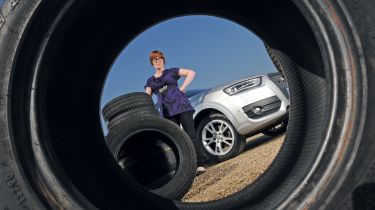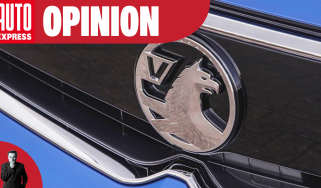Used tyre scandal
Think you’re getting a bargain with a discount part-worn? Think again, as we expose the shock state of some of the tyres on sale
Second-hand clothes ooze retro charm, but part-worn tyres don’t. Yes, they’re usually dirt-cheap – four new tyres can cost anything up to £1,000, so it’s hardly surprising that motorists buy an estimated four million part-worn tyres every year, cutting this bill in half on average. Bargain, surely? Apparently not.
Auto Express joined forces with campaign group TyreSafe to investigate the sale and condition of these cut-price, part-worn tyres in the UK, and we were horrified by what we found. Our investigation revealed a thriving black market in illegal, and in some cases lethal, second-hand tyres being sold to unwitting, cash-strapped families.
Yet these part-worn tyre retailers aren’t selling in secret – they have premises on busy high streets and their products are plastered all over the Internet. They also litter big-name auction sites, like eBay.
So you wouldn’t be blamed for thinking that part-worn tyres must be safe to buy and fit to your family car. But you’d be wrong. As part of our joint investigation, TyreSafe bought a random sample of 50 part-worns – half sourced online, half from high street retailers in the Midlands – and then inspected them back at base.
Independent tyre expert Ted Foreman – whose job it was to put them under the microscope – instantly told us all but one wasn’t even legal. Unlike the rest of Europe, the UK has strict rules on the conditions of sale of part-worn tyres. The Motor Vehicle Tyres (Safety) Regulations Act 1994 – part of the Consumer Protection Act – dictates the acceptable repair, tread depth and overall condition of rubber.
It also stipulates labelling and traceability: repairs to the rubber should carry the name and registration number of the garage that did the work. These were missing on all of our repaired tyres. Part-worns must also be ink stamped ‘part worn’ on the sidewall to show the tyre has been checked and meets all of these legal requirements. Only one of our 50 tyres bore that seal of approval – and if our sample is representative of the tyres sold across the UK, that’s a mere two per cent of the entire part-worn tyre stock.
It also means that in 98 per cent of cases, motorists buying these tyres would have no way of knowing if they were safe or not. And they could be pretty certain the seller had not adhered to UK regulations – even though part-worn tyre outlets reassure their customers to the contrary. Auto Express rang six retailers across the country at random, posing as a potential customer, and was told in each case that the tyres had been checked.
Worse still, the omission of the ‘part worn’ stamp on our sample of tyres was the tip of the iceberg – and icebergs are an accurate analogy, because our part-worns appeared in good shape to the untrained eye, but hide an array of dangers. Most had glossy black rubber and healthy tread patterns; all our tyres had at least the legal minimum 1.6mm of tread.
Ted explained: “In many cases, these tyres look great. They have loads of tread and could fool you into thinking they’re a bargain. But when you buy them, you inherit their dodgy history – every time they ran up a kerb, every accident, every time the owner drove on them under-inflated.”
Ted told us driving on under-inflated rubber damages the tyre structurally, and this accumulates over time. “If you pump them up, next time they’re under-inflated it tops up the damage you caused first time around, and eventually leads to a blow-out,” he said.
He added that most motorists wouldn’t get a chance to inspect a part-worn tyre before it was fitted, either. “You need the tyre to be removed from its rim to inspect it,” he warned. “That’s where the safety hazards lie hidden.” Ted carried out his inspection using the same safety checklist that retailers are meant to use before selling these tyres. And he found some shocking faults.
More than one third had shoddy, illegal repairs, tears or punctures that had been botched or ignored before the retailer sold them to us, posing as drivers wanting a cheap tyre to get our car through its MoT.
In some cases our stooge was a family man; in others we used a younger man posing as a cash-strapped student. But age and family status were clearly no bar to selling dangerous, illegal tyres. One of our tyres was a death trap. Ted pointed out a rusty nail, which was quite clearly sticking 5cm through the inside of its sidewall. “That could kill you,” he warned. “No doubt about it.”
Patched
Our sample also included illegal, unplugged punctures, patched on the inside. Ted compared these to open wounds. “There’s steel wire running through,” he said. “It’s like bones in a skeleton. If the protective layer of waterproof rubber is compromised, this metal will be exposed, rust and perish from the inside. This one looks like it’s been fixed with a bicycle puncture repair kit.”
So how are part-worn tyre retailers able to operate without detection or penalty? eBay didn’t seem interested in the vendors selling part-worns via its site. We sourced half of our sample from such sellers, but eBay refused to comment when we approached it.
The Office of Fair Trading couldn’t help, either, even though consumer protection is one of its remits. It suggested we contact Trading Standards, which is responsible for policing these dubious sales practices at a local authority level. But an online search for regional clampdowns revealed little, if any, action.
So these retailers are left largely unchecked, even though they face fines of up to £5,000 for flouting rules on part-worn tyres. TyreSafe chairman Stuart Jackson said: “Although a number of clear regulations exist which permit the sale of part-worn tyres, our investigation makes it obvious these are not being adhered to.”
He demanded that Trading Standards act “as a matter of urgency”. But Trading Standards may have missed the boat, claims the Tyre Industry Federation (TIF) – an independent body tasked with lobbying Government on unsafe practice in this market. It says the Department for Transport (DfT) is about to take full responsibility for all tyre regulations, including part-worns, and is appointing an agency as early as next month to enforce them. The legislation is being reviewed and tightened in preparation for this, too.
TIF chief Graham Wilson told us this would be a wake-up call to rogue traders. “The DfT will want the agency it appoints to commit to a certain level of enforcement. It will want to know how many site visits and how much mystery shopping are planned.”
Taking a gamble on a part-worn tyre is a risk that doesn’t necessarily pay off, either. We measured the tread depth of our sample tyres and compared them to the price paid to calculate a pence-per-millimetre tread figure. We then did the same for a brand new tyre of the same size, with the maximum 8mm tread depth, using an average quoted new tyre price. Surprisingly, in more than half the sizes we examined, it was better value to buy brand new tyres.
This rang true for one self-confessed part-worn tyre buyer. Colin Smith, of Wolverhampton, W Mids, told us that a cheap set he bought for his Vauxhall Calibra “lasted only 500 miles”.
“On closer inspection, I realised what a big mistake I’d made,” he said. “The tread was uneven; one showed heavy wear in the centre and the other was worn on the outsides. The previous owner clearly hadn’t run them at the right pressure.” Colin added there was a cut in the tyre sidewall, too – enough to bring an MoT failure, or three points on your licence and a fine.
But when he swapped them for another used set, he didn’t fare much better. “These didn’t hold their pressure,” he said. It turned out paint on the rim had stopped the tyre from sealing properly. A clean solved this, but Colin is still disillusioned by part-worns.
“My Vauxhall Astra Coupe has always had new tyres. Its original set lasted nine years and 55,000 miles,” he said. “So you get what you pay for.” That’s something all drivers would do well to bear in mind before they shell out on a set of potentially lethal part-worns.
Visit www.tyresafe.org for advice on part-worn tyres.
Average part-worn vs new tyre costs
| Part-worn | New | ||||
| Tyre size | Tread | Price | Cost per mm** | Price | Cost per mm** |
| 165/70 R14 | 3.84mm | £20.00 | £8.93 | £30.60 | £3.99 |
| 165/65 R14 | 5.17mm | £40.00 | £11.20 | £30.31 | £4.12 |
| 175/65 R14 | 4.90mm | £24.67 | £7.47 | £30.22 | £4.29 |
| 195/50 R15 | 5.17mm | £25.00 | £7.00 | £32.69 | £4.72 |
| 175/65 R15 | 4.25mm | £22.50 | £8.48 | £37.37 | £7.74 |
| 205/50 R16 | 3.95mm | £18.33 | £7.81 | £41.36 | £4.78 |
| 205/55 R16 | 4.00mm | £43.10 | £17.96 | £37.72 | £4.81 |
| 195/55 R15 | 5.42mm | £23.00 | £6.02 | £39.82 | £4.99 |
| 185/60 R14 | 5.17mm | £14.75 | £4.13 | £31.96 | £5.11 |
| 175/65 R16 | 4.50mm | £20.00 | £6.90 | £95.52 | £5.84 |
| 155/70 R13 | 5.06mm | £9.14 | £2.64 | £26.36 | £5.89 |
| 165/80 R13 | 5.00mm | £13.75 | £4.04 | £27.44 | £6.22 |
| 165/65 R13 | 4.50mm | £10.99 | £3.79 | £25.54 | £6.46 |
| 155/65 R14 | 4.84mm | £20.00 | £6.17 | £30.78 | £14.93 |
*To legal limit. **To legal limit, based on tread depth of 8mm.



